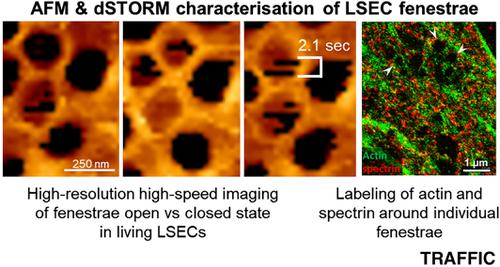Our official English website, www.x-mol.net, welcomes your
feedback! (Note: you will need to create a separate account there.)
Actin-spectrin scaffold supports open fenestrae in liver sinusoidal endothelial cells.
Traffic ( IF 3.6 ) Pub Date : 2019-10-23 , DOI: 10.1111/tra.12700 Bartlomiej Zapotoczny 1 , Filip Braet 2 , Edyta Kus 3 , Katarzyna Ginda-Mäkelä 4 , Beata Klejevskaja 4 , Roberto Campagna 3 , Stefan Chlopicki 3, 5 , Marek Szymonski 1
Traffic ( IF 3.6 ) Pub Date : 2019-10-23 , DOI: 10.1111/tra.12700 Bartlomiej Zapotoczny 1 , Filip Braet 2 , Edyta Kus 3 , Katarzyna Ginda-Mäkelä 4 , Beata Klejevskaja 4 , Roberto Campagna 3 , Stefan Chlopicki 3, 5 , Marek Szymonski 1
Affiliation

|
Fenestrae are open transmembrane pores that are a structural hallmark of healthy liver sinusoidal endothelial cells (LSECs). Their key role is the transport of solutes and macromolecular complexes between the sinusoidal lumen and the space of Disse. To date, the biochemical nature of the cytoskeleton elements that surround the fenestrae and sieve plates in LSECs remain largely elusive. Herein, we took advantage of the latest developments in atomic force imaging and super-resolution fluorescence nanoscopy to define the organization of the supramolecular complex(es) that surround the fenestrae. Our data revealed that spectrin, together with actin, lines the inner cell membrane and provided direct structural support to the membrane-bound pores. We conclusively demonstrated that diamide and iodoacetic acid (IAA) affect fenestrae number by destabilizing the LSEC actin-spectrin scaffold. Furthermore, IAA induces rapid and repeatable switching between the open vs closed state of the fenestrae, indicating that the spectrin-actin complex could play an important role in controlling the pore number. Our results suggest that spectrin functions as a key regulator in the structural preservation of the fenestrae, and as such, it might serve as a molecular target for altering transendothelial permeability.
中文翻译:

肌动蛋白-血影蛋白支架支持肝窦内皮细胞中的开放窗孔。
窗孔是开放的跨膜孔,是健康肝窦窦内皮细胞(LSEC)的结构特征。它们的关键作用是在正弦管腔与Disse空间之间传输溶质和高分子复合物。迄今为止,围绕LSEC的窗孔和筛板的细胞骨架元素的生化性质仍然难以捉摸。在这里,我们利用原子力成像和超分辨率荧光纳米技术的最新发展来定义围绕窗孔的超分子复合物的组织。我们的数据显示,血影蛋白与肌动蛋白一起排列在内部细胞膜上,并为膜结合的孔提供直接的结构支持。我们最终证明,二酰胺和碘乙酸(IAA)通过破坏LSEC肌动蛋白-血影蛋白支架的稳定性来影响窗孔数。此外,IAA诱导窗孔的打开状态与关闭状态之间快速且可重复的切换,表明血影蛋白-肌动蛋白复合物可能在控制孔数中起重要作用。我们的结果表明,血影蛋白在窗孔的结构保存中起着关键的调节剂的作用,因此,它可以作为改变跨内皮渗透性的分子靶标。
更新日期:2019-10-23
中文翻译:

肌动蛋白-血影蛋白支架支持肝窦内皮细胞中的开放窗孔。
窗孔是开放的跨膜孔,是健康肝窦窦内皮细胞(LSEC)的结构特征。它们的关键作用是在正弦管腔与Disse空间之间传输溶质和高分子复合物。迄今为止,围绕LSEC的窗孔和筛板的细胞骨架元素的生化性质仍然难以捉摸。在这里,我们利用原子力成像和超分辨率荧光纳米技术的最新发展来定义围绕窗孔的超分子复合物的组织。我们的数据显示,血影蛋白与肌动蛋白一起排列在内部细胞膜上,并为膜结合的孔提供直接的结构支持。我们最终证明,二酰胺和碘乙酸(IAA)通过破坏LSEC肌动蛋白-血影蛋白支架的稳定性来影响窗孔数。此外,IAA诱导窗孔的打开状态与关闭状态之间快速且可重复的切换,表明血影蛋白-肌动蛋白复合物可能在控制孔数中起重要作用。我们的结果表明,血影蛋白在窗孔的结构保存中起着关键的调节剂的作用,因此,它可以作为改变跨内皮渗透性的分子靶标。











































 京公网安备 11010802027423号
京公网安备 11010802027423号